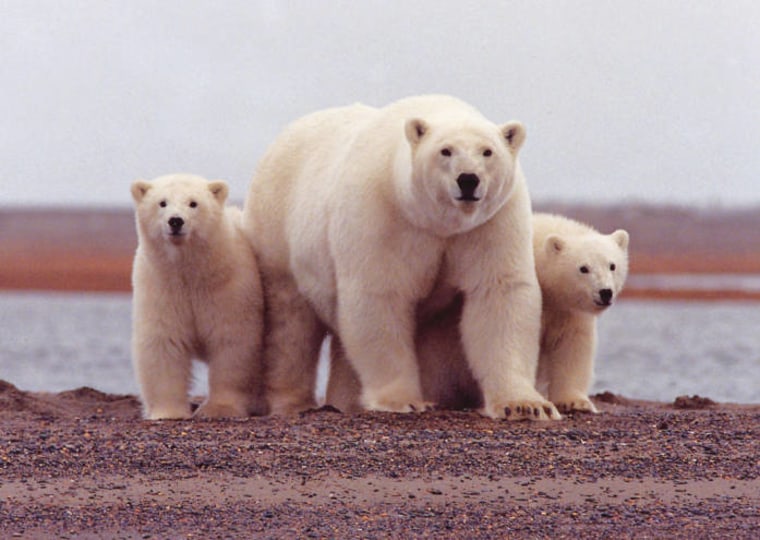The Obama administration on Thursday proposed setting aside 200,000 square miles off Alaska and along its shorelines as "critical habitat" for polar bears — an action that could add restrictions to future offshore drilling for oil and gas.
"Proposing critical habitat for this iconic species is one step in the right direction to help this species stave off extinction," Tom Strickland, interior assistant secretary for fish, wildlife and parks, said in a statement. "The greatest threat to the polar bear is the melting of Arctic sea ice caused by climate change."
Environmentalists welcomed the move, but some worried it might have little impact if the administration does not do more to curb emissions of greenhouse gases tied to warming.
"My initial impression is that the actual area proposed for critical habitat is quite good," said Brendan Cummings of the Center for Biological Diversity. But, he added, "the devil is in the details" and "all the disclaimers" that the Fish and Wildlife Service "gave with it on how the designation likely won’t affect oil development or be used to regulate greenhouse emissions is where the legal battle will be fought down the line."
The federal agency on Thursday opened a 60-day public review period, which will be followed by a final decision.
'Schizo' department?
The center, which sued to speed up release of the proposed habitat, noted that earlier this week the Interior Department approved plans for new exploratory drilling in polar bear habitat in the Beaufort Sea off Alaska.
"The Interior Department is schizophrenic, declaring its intent to protect polar bear habitat in the Arctic, yet simultaneously sacrificing that habitat to feed our unsustainable addiction to oil.," said Cummings, the group's senior attorney.
Greenpeace echoed that view. "Designating polar bear critical habitat is a good first step," said Melanie Duchin, a Greenpeace campaigner in Anchorage, Alaska. "However, as long as the secretary of the interior maintains that he can do nothing about greenhouse emissions and global warming, protections for the polar bear will ultimately be ineffective."
The Bush administration last year declared polar bears "threatened," or likely to become endangered —triggering a prohibition on government agencies from taking actions that may adversely modify critical habitat and interfere with polar bear recovery.
Controversial exemption
But the Bush administration also issued a rule stating that the Endangered Species Act may not be used to require reduced greenhouse gas emissions.
Last May, the Obama administration reaffirmed that exemption. The Center for Biological Diversity, the Natural Resources Defense Council and Greenpeace are fighting that rule in court.
Half of the proposed habitat area is in the rugged Chukchi Sea off Alaska's northwest coast. About 93 percent of the area proposed for the polar bear is sea ice, with the remaining 7 percent made up of barrier islands or land-based dens of snow and ice.
Polar bears are completely dependent upon sea ice for survival. "They use sea ice as a platform to hunt and feed upon seals, as a habitat on which to seek mates and breed, as a platform to move to onshore maternity denning areas, and make long-distance movements, and occasionally for maternity denning," Fish and Wildlife said in a statement. "Most populations use onshore habitat partially or exclusively for maternity denning."
Alaska opposes listing
The announcement comes one day after the state of Alaska filed a new complaint in its effort to overturn the listing of the polar bear as threatened under the Endangered Species Act.
Then Alaska Gov. Sarah Palin filed suit last year, saying that Interior did not respond to the state's concerns in a timely manner before listing the polar bears as threatened. State officials say the listing could cripple offshore oil and gas development in the Chukchi and Beaufort seas.
Gov. Sean Parnell, who succeeded Palin upon her resignation last summer, said the Endangered Species Act was being used as a way to shut down resource development along Alaska's northern coast. Parnell said he does not intend to let that happen.
Environmental groups monitoring the Arctic have long complained that federal regulators routinely grant permits for petroleum exploration without adequately considering consequences for whales, polar bears, walrus and other marine mammals. They say boats, drilling platforms and aircraft will add to bears' stress by causing them to flee and expend more energy.
Conservation groups also say oil companies have not demonstrated they can clean up an oil spill in broken ice. Cleanup off Alaska's coast could be slowed by extreme cold, moving ice, high wind and low visibility.
The habitat listing applies only to polar bears in U.S. territory. They also live in Arctic areas controlled by other countries, such as Canada and Russia.
Some populations appear healthy but overall the species is in decline. Experts with the International Union for the Conservation of Nature recently concluded that the overall population is likely to fall by 30 percent within 50 years due mainly to warming.
